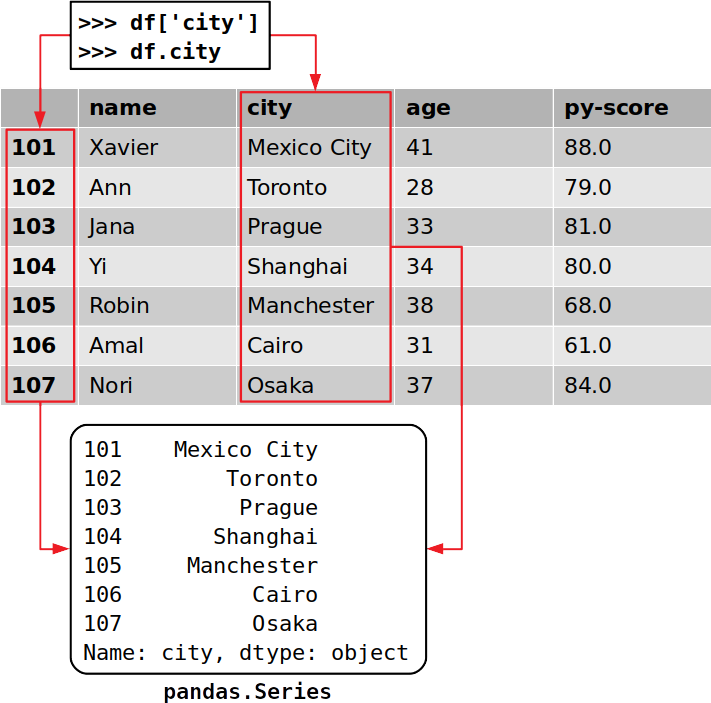44 pandas series get labels
Pandas Series - W3Schools Create a simple Pandas Series from a list: import pandas as pd a = [1, 7, 2] myvar = pd.Series (a) print(myvar) Try it Yourself » Labels If nothing else is specified, the values are labeled with their index number. First value has index 0, second value has index 1 etc. This label can be used to access a specified value. Example Labeling Data with Pandas. Introduction to Data Labeling ... We can use the Pandas '.loc []' method to assign ternary labels to the data, which would segment the data into three groups. The label of '0' will be assigned to values (4-7), '1' will be assigned to values (7-9), and '2' will be assigned to values (9-16):
sparkbyexamples.com › pandas › pandas-get-column-namesPandas Get Column Names from DataFrame - Spark by {Examples} You can get the column names from pandas DataFrame using df.columns.values, and pass this to python list() function to get it as list, once you have the data you can print it using print() statement. I will take a moment to explain what is happening on this statement, df.columns attribute returns an Index object which is a basic object that ...

Pandas series get labels
python - How to print x-axes labels in pandas.Series.plot ... For that purpose, I use the below and get desired output - df.groupby ('owner_team').inc_subj.count ().plot.bar (ylim=0) Output - My concern is the x-axes labels are shown as numbers, which is the exactly values present. But, my desire is to see the names (string values) corresponding to those numbers. Python Pandas Series - Python Examples To create Pandas Series in Python, pass a list of values to the Series () class. Pandas will create a default integer index. In the following example, we will create a pandas Series with integers. Python Program import numpy as np import pandas as pd s = pd.Series([1, 3, 5, 12, 6, 8]) print(s) Run Output 0 1 1 3 2 5 3 12 4 6 5 8 dtype: int64 pandas.Series.loc — pandas 1.4.2 documentation pandas.Series.loc ¶ property Series.loc ¶ Access a group of rows and columns by label (s) or a boolean array. .loc [] is primarily label based, but may also be used with a boolean array. Allowed inputs are: A single label, e.g. 5 or 'a', (note that 5 is interpreted as a label of the index, and never as an integer position along the index).
Pandas series get labels. pandas.Series.loc — pandas 0.25.0.dev0+752.g49f33f0d ... Access a group of rows and columns by label (s) or a boolean array. .loc [] is primarily label based, but may also be used with a boolean array. Allowed inputs are: A single label, e.g. 5 or 'a', (note that 5 is interpreted as a label of the index, and never as an integer position along the index). A list or array of labels, e.g. ['a', 'b', 'c']. Python Tryit Editor v1.0 - W3Schools Run Get your own website Result Size: 497 x 414. ... x . import pandas as pd a = [1, 7, 2] myvar = pd. Series (a, index = ["x", "y", "z"]) print (myvar) x 1 y 7 z 2 dtype: int64 ... › python-pandas-seriesPython | Pandas Series - GeeksforGeeks Jan 17, 2019 · Pandas Series is a one-dimensional labeled array capable of holding data of any type (integer, string, float, python objects, etc.). The axis labels are collectively called index. Pandas Series is nothing but a column in an excel sheet. Labels need not be unique but must be a hashable type. realpython.com › pandas-dataframeThe Pandas DataFrame: Make Working With Data Delightful It’s important to notice that you’ve extracted both the data and the corresponding row labels: Each column of a Pandas DataFrame is an instance of pandas.Series, a structure that holds one-dimensional data and their labels. You can get a single item of a Series object the same way you would with a dictionary, by using its label as a key: >>>
Pandas Lesson 1: Series - Practical Data Science An index is a set of labels for each observation in a Series. If you don't specify an index when you create a Series, pandas will just create a default index that just labels each row with its initial row number, but you can specify an index if you want. A Practical Introduction to Pandas Series | by B. Chen ... A practical introduction to Pandas Series (Image by Author using canva.com). DataFrame and Series are two core data structures in Pandas.DataFrame is a 2-dimensional labeled data with rows and columns. It is like a spreadsheet or SQL table. Series is a 1-dimensional labeled array. It is sort of like a more powerful version of the Python list.Understanding Series is very important, not only ... Pandas Series: drop() function - w3resource Pandas Series: drop() function Last update on April 18 2022 10:49:37 (UTC/GMT +8 hours) Remove series with specified index labels. The drop() function is used to get series with specified index labels removed. Remove elements of a Series based on specifying the index labels. When using a multi-index, labels on different levels can be removed by ... pandas Tutorial => Select column by label Filtering columns (selecting "interesting", dropping unneeded, using RegEx, etc.) Get the first/last n rows of a dataframe. Mixed position and label based selection. Path Dependent Slicing. Select by position. Select column by label. Select distinct rows across dataframe. Slicing with labels. IO for Google BigQuery.
› python-pandas-series-getPython | Pandas Series.get() - GeeksforGeeks Feb 13, 2019 · Pandas series is a One-dimensional ndarray with axis labels. The labels need not be unique but must be a hashable type. The object supports both integer- and label-based indexing and provides a host of methods for performing operations involving the index. Python Pandas - Series - Tutorialspoint A Series is like a fixed-size dict in that you can get and set values by index label. Example 1 Retrieve a single element using index label value. Live Demo import pandas as pd s = pd.Series( [1,2,3,4,5],index = ['a','b','c','d','e']) #retrieve a single element print s['a'] Its output is as follows − 1 Example 2 How to get the index and values of series in Pandas? A pandas Series holds labeled data, by using these labels we can access series elements and we can do manipulations on our data. However, in some situations, we need to get all labels and values separately. Labels can be called indexes and data present in a series called values. If you want to get labels and values individually. pandas.pydata.org › api › pandaspandas.Series — pandas 1.4.2 documentation pandas.Series — pandas 1.4.2 documentation pandas.Series ¶ class pandas.Series(data=None, index=None, dtype=None, name=None, copy=False, fastpath=False) [source] ¶ One-dimensional ndarray with axis labels (including time series). Labels need not be unique but must be a hashable type.
Pandas Select Rows by Index (Position/Label) - Spark by ... Use pandas.DataFrame.loc [] to Select Rows by Index Labels By using pandas.DataFrame.loc [] you can select rows by index names or labels.
› python-pandas-seriesPython Pandas Series - javatpoint Python Pandas Series. The Pandas Series can be defined as a one-dimensional array that is capable of storing various data types. We can easily convert the list, tuple, and dictionary into series using "series' method. The row labels of series are called the index. A Series cannot contain multiple columns. It has the following parameter:
Python | Pandas Series - Tutorialspoint.dev Python | Pandas Series. Pandas Series is a one-dimensional labeled array capable of holding data of any type (integer, string, float, python objects, etc.). The axis labels are collectively called index. Pandas Series is nothing but a column in an excel sheet. Labels need not be unique but must be a hashable type.
pandas.pydata.org › api › pandaspandas.Series.plot — pandas 1.4.2 documentation pandas.Series.plot ¶ Series. plot (* args ... In case subplots=True, share y axis and set some y axis labels to invisible. layout tuple, optional (rows, columns) for ...
Convert Pandas Series to a List - Data Science Parichay There are a number of ways to get a list from a pandas series. You can use the tolist () function associated with the pandas series or pass the series to the python built-in list () function. The following is the syntax to use the above functions: # using tolist () ls = s.tolist() # using list () ls = list(s)
how to Access the elements of a Series in python - pandas ... Accessing data from series with Labels or index: A Series is like a fixed-size dictionary in that you can get and set values by index label. Retrieve a single element using index label: # create a series import pandas as pd import numpy as np data = np.array(['a','b','c','d','e','f']) s = pd.Series(data,index=[100,101,102,103,104,105]) print s ...
Pandas Series: idxmax() function - w3resource Get the row label of the maximum value in Pandas series . The idxmax() function is used to get the row label of the maximum value. If multiple values equal the maximum, the first row label with that value is returned. Syntax: Series.idxmax(self, axis=0, skipna=True, *args, **kwargs) Parameters:
How to get the names (titles or labels) of a pandas data ... Examples of how to get the names (titles or labels) of a pandas data frame in python. Summary. Get the row names of a pandas data frame; Get the row names of a pandas data frame (Exemple 1) ... Get the row names of a pandas data frame (Exemple 2) Another example using the csv file train.csv ...







Post a Comment for "44 pandas series get labels"